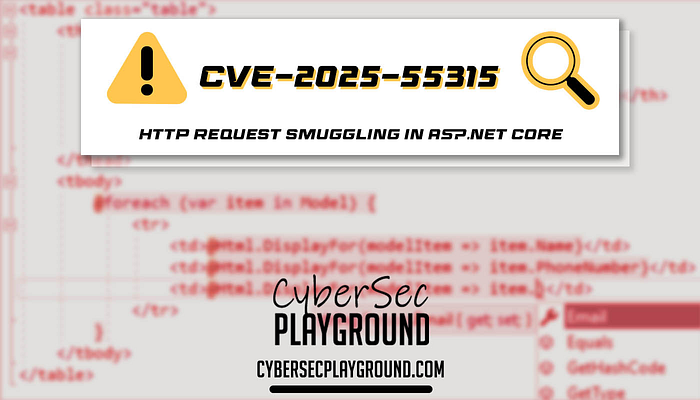CRITICAL ALERT: CVE-2025–55315 — HTTP Request Smuggling in ASP.NET Core (Kestrel)
Severity: CRITICAL (CVSS 9.9) Vulnerability: HTTP Request/Response Smuggling (CWE-444) in Kestrel web server (ASP.NET Core) Status: Patches available — urgent patching recommended POC : LINK
🔥 Summary
CVE-2025–55315 is a high-severity HTTP request smuggling vulnerability in ASP.NET Core's Kestrel web server. Due to inconsistent parsing between front-end proxies/load-balancers and Kestrel, an attacker can smuggle a malicious HTTP request inside another, bypassing security controls and causing severe impacts including authentication bypass, SSRF, data exposure, and potential full compromise.
🛠 Technical Breakdown
Request smuggling occurs when a front-end component (e.g., proxy, CDN, WAF) and a backend server interpret the boundaries of HTTP requests differently. An attacker crafts a single TCP-level payload that contains two logical HTTP requests. The front-end forwards one request to the backend while the backend processes the hidden request — giving the attacker a way to bypass filters, inject requests, or tamper with session state.
Potential outcomes include:
- Authentication bypass or privilege escalation
- Server-Side Request Forgery (SSRF) to internal resources (e.g., metadata endpoints)
- Circumventing CSRF protections, caching logic, or logging
- Data exfiltration or request/response tampering
⚠️ Affected Versions & Patches (apply immediately)
- ASP.NET Core 8.0: <= 8.0.20 → update to 8.0.21
- ASP.NET Core 9.0: <= 9.0.9 → update to 9.0.10
- ASP.NET Core 10.0 RC1: update to RC2
- Kestrel.Core package: <= 2.3.0 → update to 2.3.6
- Note: .NET 6 is affected but is end-of-life and will not receive official patches — consider upgrade/migration and mitigations.
🛡 Immediate Mitigation & Hardening
If you cannot patch immediately, apply risk-reduction steps:
- Patch first — prioritize applying vendor fixes.
- Restart applications after runtime updates; recompile & redeploy self-contained apps.
- Harden front-end proxies/WAFs — configure them to reject ambiguous or non-conformant HTTP requests and to normalize headers (Content-Length / Transfer-Encoding discrepancies).
- Deny ambiguous transfer encodings — block requests with both
Content-LengthandTransfer-Encodingdiscrepancies. - Restrict internal endpoint access — isolate management and metadata services from the application network.
- Network monitoring — monitor for anomalous request patterns, unexpected backend connections, and doubled or pipelined requests.
- Temporary WAF rules — create signatures to block known exploitation patterns until patches are applied.
🔍 Detection & Hunting
- Search logs for suspicious patterns: multiple HTTP requests in a single TCP stream, unexpected HTTP verbs or header anomalies, or backend processing of unexpected requests.
- Monitor for unusual session hijacks, unexplained cached response tampering, or internal-request bursts.
- Use IDS signatures that detect smuggling patterns (e.g., conflicting
Content-LengthvsTransfer-Encodingheaders).
📚 References & Resources
- Microsoft Security Advisory / Patch: check official Microsoft .NET/ASP.NET security pages for vendor guidance and KB links.
- OWASP Request Smuggling: https://owasp.org/www-community/attacks/HTTP_Request_Smuggling
- Project/Community write-ups and detection templates (search community repos and Nuclei templates for CVE-2025–55315)
🧾 Incident Response Notes
- If compromise is suspected: isolate affected hosts, preserve network logs (PCAPs), collect full request logs, and coordinate with your vendor or incident response provider.
- Rotate secrets and credentials that may have been exposed.
- Conduct a full audit of ingress points (proxies, gateways, load balancers) to ensure consistent HTTP parsing and normalization.
Share widely — patch immediately. Prepared by @cybersecplayground — follow for real-time CVE alerts and remediation tips.
#CVE2025_55315 #ASPNET #Kestrel #RequestSmuggling #PatchNow #CyberSecurity

